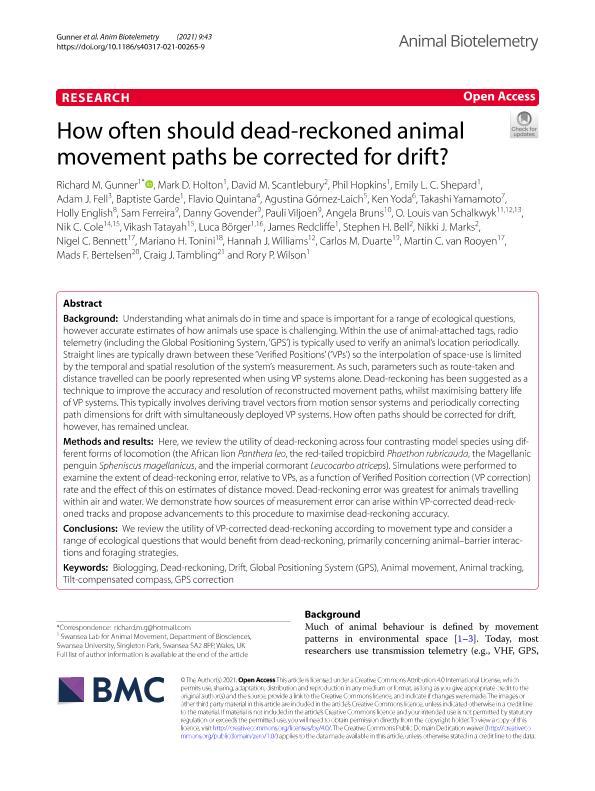Artículo
How often should dead-reckoned animal movement paths be corrected for drift?
Gunner, Richard M.; Holton, Mark; Scantlebury, David M.; Hopkins, Phil; Shepard, Emily L. C.; Fell, Adam J.; Garde, Baptiste; Quintana, Flavio Roberto ; Gómez Laich, Agustina Marta
; Gómez Laich, Agustina Marta ; Yoda, Ken; Yamamoto, Takashi; English, Holly M.; Ferreira, Sam; Govender, Danny; Viljoen, Pauli; Bruns, Angela; van Schalkwyk, O. Louis; Cole, Nik C.; Tatayah, Vikash; Börger, Luca; Redcliffe, James; Bell, Stephen H.; Marks, Nikki J.; Bennett, Nigel C.; Tonini, Mariano Hernan
; Yoda, Ken; Yamamoto, Takashi; English, Holly M.; Ferreira, Sam; Govender, Danny; Viljoen, Pauli; Bruns, Angela; van Schalkwyk, O. Louis; Cole, Nik C.; Tatayah, Vikash; Börger, Luca; Redcliffe, James; Bell, Stephen H.; Marks, Nikki J.; Bennett, Nigel C.; Tonini, Mariano Hernan ; Williams, Hannah J.; Duarte, Carlos M.; van Rooyen, Martin C.; Bertelsen, Mads F.; Tambling, Craig J.; Wilson, Rory P.
; Williams, Hannah J.; Duarte, Carlos M.; van Rooyen, Martin C.; Bertelsen, Mads F.; Tambling, Craig J.; Wilson, Rory P.
 ; Gómez Laich, Agustina Marta
; Gómez Laich, Agustina Marta ; Yoda, Ken; Yamamoto, Takashi; English, Holly M.; Ferreira, Sam; Govender, Danny; Viljoen, Pauli; Bruns, Angela; van Schalkwyk, O. Louis; Cole, Nik C.; Tatayah, Vikash; Börger, Luca; Redcliffe, James; Bell, Stephen H.; Marks, Nikki J.; Bennett, Nigel C.; Tonini, Mariano Hernan
; Yoda, Ken; Yamamoto, Takashi; English, Holly M.; Ferreira, Sam; Govender, Danny; Viljoen, Pauli; Bruns, Angela; van Schalkwyk, O. Louis; Cole, Nik C.; Tatayah, Vikash; Börger, Luca; Redcliffe, James; Bell, Stephen H.; Marks, Nikki J.; Bennett, Nigel C.; Tonini, Mariano Hernan ; Williams, Hannah J.; Duarte, Carlos M.; van Rooyen, Martin C.; Bertelsen, Mads F.; Tambling, Craig J.; Wilson, Rory P.
; Williams, Hannah J.; Duarte, Carlos M.; van Rooyen, Martin C.; Bertelsen, Mads F.; Tambling, Craig J.; Wilson, Rory P.
Fecha de publicación:
12/2021
Editorial:
BioMed Central
Revista:
Animal Biotelemetry
e-ISSN:
2050-3385
Idioma:
Inglés
Tipo de recurso:
Artículo publicado
Clasificación temática:
Resumen
Background: Understanding what animals do in time and space is important for a range of ecological questions, however accurate estimates of how animals use space is challenging. Within the use of animal-attached tags, radio telemetry (including the Global Positioning System, ‘GPS’) is typically used to verify an animal’s location periodically. Straight lines are typically drawn between these ‘Verified Positions’ (‘VPs’) so the interpolation of space-use is limited by the temporal and spatial resolution of the system’s measurement. As such, parameters such as route-taken and distance travelled can be poorly represented when using VP systems alone. Dead-reckoning has been suggested as a technique to improve the accuracy and resolution of reconstructed movement paths, whilst maximising battery life of VP systems. This typically involves deriving travel vectors from motion sensor systems and periodically correcting path dimensions for drift with simultaneously deployed VP systems. How often paths should be corrected for drift, however, has remained unclear. Methods and results: Here, we review the utility of dead-reckoning across four contrasting model species using different forms of locomotion (the African lion Panthera leo, the red-tailed tropicbird Phaethon rubricauda, the Magellanic penguin Spheniscus magellanicus, and the imperial cormorant Leucocarbo atriceps). Simulations were performed to examine the extent of dead-reckoning error, relative to VPs, as a function of Verified Position correction (VP correction) rate and the effect of this on estimates of distance moved. Dead-reckoning error was greatest for animals travelling within air and water. We demonstrate how sources of measurement error can arise within VP-corrected dead-reckoned tracks and propose advancements to this procedure to maximise dead-reckoning accuracy. Conclusions: We review the utility of VP-corrected dead-reckoning according to movement type and consider a range of ecological questions that would benefit from dead-reckoning, primarily concerning animal–barrier interactions and foraging strategies.
Archivos asociados
Licencia
Identificadores
Colecciones
Articulos(IBIOMAR)
Articulos de INSTITUTO DE BIOLOGIA DE ORGANISMOS MARINOS
Articulos de INSTITUTO DE BIOLOGIA DE ORGANISMOS MARINOS
Articulos(IEGEBA)
Articulos de INSTITUTO DE ECOLOGIA, GENETICA Y EVOLUCION DE BS. AS
Articulos de INSTITUTO DE ECOLOGIA, GENETICA Y EVOLUCION DE BS. AS
Articulos(IPATEC)
Articulos de INSTITUTO ANDINO PATAGONICO DE TECNOLOGIAS BIOLOGICAS Y GEOAMBIENTALES
Articulos de INSTITUTO ANDINO PATAGONICO DE TECNOLOGIAS BIOLOGICAS Y GEOAMBIENTALES
Citación
Gunner, Richard M.; Holton, Mark; Scantlebury, David M.; Hopkins, Phil; Shepard, Emily L. C.; et al.; How often should dead-reckoned animal movement paths be corrected for drift?; BioMed Central; Animal Biotelemetry; 9; 1; 12-2021; 1-22
Compartir
Altmétricas



